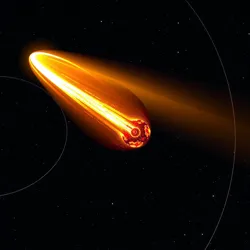Arrival of the Celestial Wanderer
The Arrival of the Celestial Wanderer is a rare astronomical event involving the return of a comet known as the Celestial Wanderer. This comet is noted for its extremely elongated orbit, bringing it into the inner regions of our solar system approximately once every 2,000 years. Its appearance has been a significant event for astronomers and has generated considerable interest due to its potential role in understanding the origins of life in the universe.

Characteristics of the Celestial Wanderer
The Celestial Wanderer is distinguished by its vast tail, which extends millions of kilometers into space, composed primarily of gas and dust. Observations have indicated that the comet carries a variety of organic compounds, including complex carbon-based molecules. These compounds are of particular interest as they may represent some of the building blocks of life. Studies suggest that these materials could have been delivered to early Earth by similar cometary bodies, potentially influencing the development of life.
Orbit and Observation
The comet's orbit is highly eccentric, leading it to spend the majority of its time in the distant reaches of the solar system. It is believed to originate from the Oort Cloud, a hypothetical cloud of icy bodies surrounding the solar system. The Celestial Wanderer's return is a rare opportunity for scientists to study such ancient objects, offering insights into the conditions of the early solar system.
Astronomers have been preparing for the comet's arrival for decades, utilizing both ground-based telescopes and space missions to capture detailed observations. The current close approach has allowed for unprecedented study of its composition and behavior.
Historical Significance
Historical records from various cultures suggest that past appearances of the Celestial Wanderer were often noted and sometimes regarded with mythological significance. Ancient texts describe the comet as a harbinger of change, often associated with significant historical events. The comet's last recorded visit was during a time of considerable upheaval on Earth, which has only added to its mystique.
Scientific Implications
The study of the Celestial Wanderer has significant implications for several fields of science, including astrobiology and planetary science. The discovery of organic compounds in its tail supports the theory of panspermia, which posits that life can be distributed throughout the universe via comets and asteroids. Additionally, understanding the comet's composition and structure aids in modeling the processes that formed our solar system.
See Also
- Mysteries of the Moon of Vespera
- The Silent Galaxy: Auroria
- The Origins of Life: Cosmic Beginnings
- The Physics of the Unknown: Gravitational Wonders
- Speculative Geology: Formations Beyond Earth
References
- The Cosmic Journey of Celestial Wanderers
- Astrobiology and the Role of Comets
- Historical Accounts of Celestial Events
The reappearance of the Celestial Wanderer continues to captivate and challenge our understanding of the cosmos, reminding us of the vast and interconnected nature of the universe.